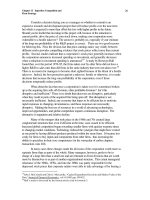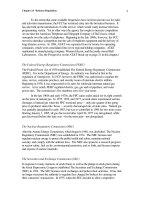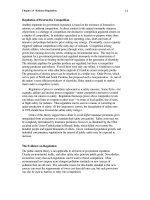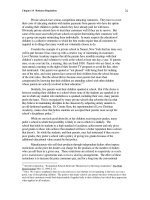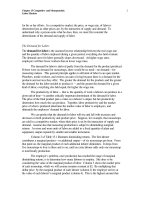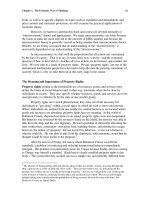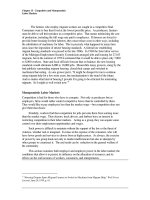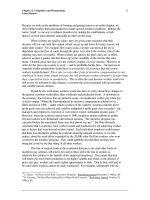Microeconomics for MBAs 5
Bạn đang xem bản rút gọn của tài liệu. Xem và tải ngay bản đầy đủ của tài liệu tại đây (119.84 KB, 10 trang )
Chapter 1. The Economic Way of Thinking
40
Leave Men Free
The lesson I have to teach is this: Leave all creative energies uninhibited. Merely organize society to act in
harmony with this lesson. Let society’s legal apparatus remove all obstacles the best it can. Permit
creative know-how to freely flow. Have faith that free men will respond to the “Invisible Hand.” This
faith will be confirmed. I, Pencil, seemingly simple though I am, offer the miracle of my creation as
testimony that this is a practical faith, as practical as the sun, the rain, a cedar tree, and the good earth.
CHAPTER 2
Competitive Product Markets
And Firm Decisions
Competition, if not prevented, tends to bring about a state of affairs in which: first,
everything will be produced which somebody knows how to produce and which he can
sell profitably at a price at which buyers will prefer it to the available alternatives:
second, everything that is produced is produced by persons who can do so at least as
cheaply as anybody else who in fact is not producing it: and third, that everything will be
sold at prices lower than, or at least as low as, those at which it could be sold by anybody
who in fact does not do so.
Friedrich Hayek
n the heart of New York City, Fred Lieberman’s small grocery is dwarfed by the tall
buildings that surround it. Yet it is remarkable for what it accomplishes. Lieberman’s
carries thousands of items, most of which are not produced locally, and some of which
come thousands of miles from other parts of this country or abroad. A man of modest means,
with little knowledge of production processes, Fred Lieberman has nevertheless been able to
stock his store with many if not most of the foods and toiletries his customers need and want.
Occasionally Lieberman’s runs out of certain items, but most of the time the stock is ample. Its
supply is so dependable that customers tend to take it for granted, forgetting that Lieberman’s is
one small strand in an extremely complex economic network.
How does Fred Lieberman get the goods he sells, and how does he know which ones
to sell and at what price? The simplest answer is that the goods he offers and the prices at
which they sell are determined through the market process- the interaction of many buyers and
sellers trading what they have (their labor or other resources) for what they want. Lieberman
stocks his store by appealing to the private interests of suppliers -- by paying them competitive
prices. His customers pay him extra for the convenience of purchasing goods in their
neighborhood grocery -- in the process appealing to his private interests. To determine what he
should buy, Fred Lieberman considers his suppliers prices. To determine what and how much
they should buy, his customers consider the prices he charges. The Nobel Prize-winning
economist Friedrich Hayek has suggested that the market process is manageable for people like
Fred Lieberman precisely because prices condense into usable form a great deal of information,
signaling quickly what people want, what goods cost, and what resources are readily available.
Prices guide and coordinate the sellers’ production decisions and consumers’ purchases.
How are prices determined? That is an important question for people in business simply
because an understanding of how prices are determined can help business people understand
I
Chapter 2 Competitive Product Markets
2
the forces that will cause prices to change in the future and, therefore, the forces that affect their
businesses’ bottom lines. There’s money to be made in being able to understand the dynamics
of prices. Our most general answer in this chapter to the question is deceptively simple: In
competitive markets, the forces of supply and demand establish prices. However, there is much
to be learned through the concepts of supply and demand. Indeed, we suspect that most MBA
students will find supply and demand the most useful concepts developed in this book.
However, to understand supply and demand, you must first understand the market process that
is inherently competitive.
The Competitive Market Process
So far, our discussion of markets and their consequences has been rather casual. In this section
we will define precisely such terms as market and competition. In later sections we will examine
the way markets work and learn why, in a limited sense, markets can be considered efficient
systems for determining what and how much to produce.
The Market Setting
Most people tend to think of a market as a geographical location -- a shopping center, an
auction bar, a business district. From an economic perspective, however, it is more useful to
think of a market as a process. You may recall from Chapter 1 that a market is defined as the
process by which buyers and sellers determine what they are willing to buy and sell and on what
terms. That is, it is the process by which buyers and sellers decide the prices and quantities of
goods to be bought and sold.
In this process, individual market participants search for information relevant to their
own interests. Buyers ask about the models, sizes, colors, and quantities available and the
prices they must pay for them. Sellers inquire about the types of goods and services buyers
want and the prices they are willing to pay.
This market process is self-correcting. Buyers and sellers routinely revise their plans on
the basis of experience. As Israel Kirzner has written,
The overly ambitious plans of one period will be replaced by more realistic
ones; market opportunities overlooked in one period will be exploited in the
next. In other words, even without changes in the basic data of the market, the
decision made in one period onetime generates systematic alterations in
corresponding decisions for the succeeding period.
1
The market is made up of people, consumers and entrepreneurs, attempting to buy and
sell on the best terms possible. Through the groping process of give and take, they move from
relative ignorance about others’ wants and needs to a reasonably accurate understanding of
1
Israel Kirzner, Competition and Entrepreneurship (Chicago: University of Chicago Press, 1973), p. 10.
Chapter 2 Competitive Product Markets
3
how much can be bought and sold and at what price. The market functions as an ongoing
information and exchange system.
Competition Among Buyers and Among Sellers
Part and parcel of the market process is the concept of competition. Competition is the
process by which market participants, in pursuing their own interests, attempt to outdo,
outprice, outproduce, and outmaneuver each other. By extension, competition is also the
process by which market participants attempt to avoid being outdone, outpriced, outproduced,
or outmaneuvered by others.
Competition does not occur between buyer and seller, but among buyers or among
sellers. Buyers compete with other buyers for the limited number of goods on the market. To
compete, they must discover what other buyers are bidding and offer the seller better terms -- a
higher price or the same price for a lower-quality product. Sellers compete with other sellers
for the consumer’s dollar. They must learn what their rivals are doing and attempt to do it better
or differently -- to lower the price or enhance the product’s appeal.
This kind of competition stimulates the exchange of information, forcing competitors to
reveal their plans to prospective buyers or sellers. The exchange of information can be seen
clearly at auctions. Before the bidding begins, buyer look over the merchandise and the other
buyers, attempting to determine how high others might be willing to bid for a particular piece.
During the auction, this specific information is revealed as buyers call out their bids and others
try to top them. Information exchange is less apparent in department stores, where competition
is often restricted. Even there, however, comparison-shopping will often reveal some sellers
who are offering lower prices in an attempt to attract consumers.
In competing with each other, sellers reveal information that is ultimately of use to
buyers. Buyers likewise inform sellers. From the consumer’s point of view,
The function of competition is here precisely to teach us who will serve us well:
which grocer or travel agent, which department store or hotel, which doctor or
solicitor, we can expect to provide the most satisfactory solution for whatever
particular personal problem we may have to face.
2
From the seller’s point of view -- say, the auctioneer’s -- competition among buyers brings the
highest prices possible.
Competition among sellers takes many forms, including the price, quality, weight,
volume, color, texture, poor durability, and smell of products, as well as the credit terms offered
to buyers. Sellers also compete for consumers’ attention by appealing to their hunger and sex
drives or their fear of death, pain, and loud noises. All these forms of competition can be
divided into two basic categories -- price and nonprice competition. Price competition is of
particular interest to economists, who see it as an important source of information for market
2
Friedrich H. Hayek, “The Meaning of Competition,” Individualism and Economic Order (Chicago:
University of Chicago Press, 1948), p. 97.
Chapter 2 Competitive Product Markets
4
participants and a coordinating force that brings the quantity produced into line with the quantity
consumers are willing and able to buy. In the following sections, we will construct a model of
the competitive market and use it to explore the process of price competition. Nonprice
competition will be covered in a later section.
Supply and Demand: A Market Model
A fully competitive market is made up of many buyers and sellers searching for opportunities or
ready to enter the market when opportunities arise. To be described as competitive, therefore,
a market must include a significant number of actual or potential competitors. A fully
competitive market offers freedom of entry: there are no legal or economic barriers to producing
and selling goods in the market.
Our market model assumes perfect competition-an ideal situation that is seldom, if ever,
achieved in real life but that will simplify our calculations. Perfect competition is a market
composed of numerous independent sellers and buyers of an identical product, such that no one
individual seller or buyer has the ability to affect the market price by changing the production
level. Entry into and exit from a perfectly competitive market is unrestricted. Producers can
start up or shut down production at will. Anyone can enter the market, duplicate the good, and
compete for consumers’ dollars. Since each competitor produces only a small share of the total
output, the individual competitor cannot significantly influence the degree of competition or the
market price by entering or leaving the market.
This kind of market is well suited to graphic analysis. Our discussion will concentrate
on how buyers and sellers interact to determine the price of tomatoes, a product Mr. Lieberman
almost always carries. It will employ two curves. The first represents buyers’ behavior, which
is called their demand for the product.
The Elements of Demand
To the general public, demand is simply what people want, but to economists, demand has
much more technical meaning. Demand is the assumed inverse relationship between the price
of a good or service and the quantity consumers are willing and able to buy during a given
period, all other things held constant.
Demand as a Relationship
The relationship between price and quantity is normally assumed to be inverse. That is, when
the price of a good rises, the quantity sold, ceteris paribus (Latin for “everything else held
constant”), will go down. Conversely, when the price of a good falls, the quantity sold goes up.
Demand is not a quantity but a relationship. A given quantity sold at a particular price is
properly called quantity demanded.
